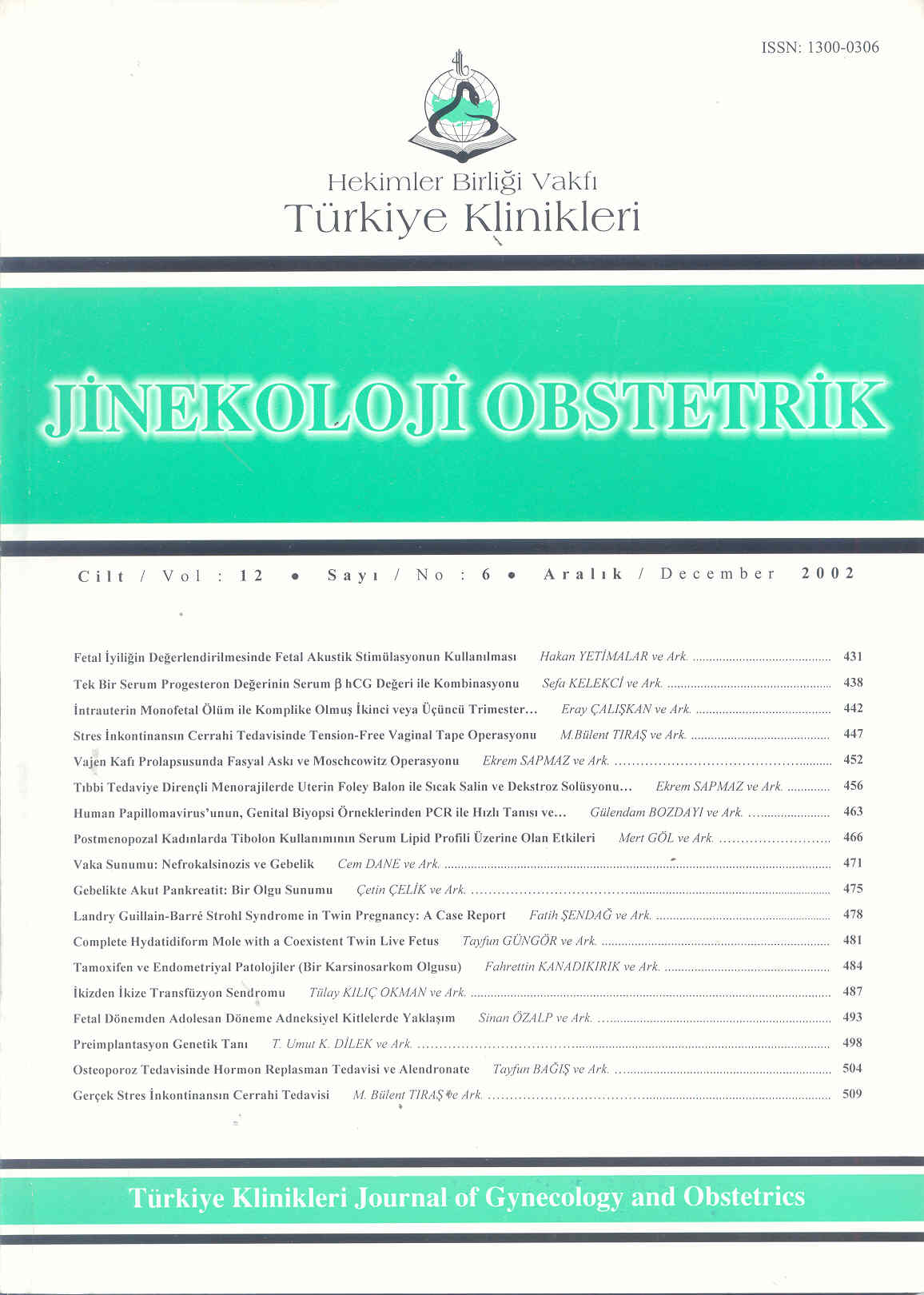Open Access
Peer Reviewed
ARTICLES
3292 Viewed975 Downloaded
Complete Hydatidiform Mole with a CoexistentTwin Live Fetus: Analysis of Two Cases
Canli İki̇z Fetusun Eşli̇k Etti̇ği̇ Komplet Mol Hi̇dati̇di̇form: İki̇ Olgunun Anali̇zi̇
Turkiye Klinikleri J Gynecol Obst. 2002;12(6):481-3
Article Language: TR
Copyright Ⓒ 2025 by Türkiye Klinikleri. This is an open access article under the CC BY-NC-ND license (http://creativecommons.org/licenses/by-nc-nd/4.0/)
ÖZET
Mol hidatidiform olgularında canlı fetusun birlikte bılunması nadir bir durumdur. Komplet mol hidatidiformla birlikte canlı fetus ve normal plasentanın bulunduğu ikiz gebelik olguları daha da nadir bir antitedir. Bu olgular, yanlış veya geç tanı almaları, fetal anomali riski olması, artmış maternal komplikasyonlar, artmış persistan gestasyonel trofoblastik tümör (PGTT) ve metastaz gelişme riski nedeniyle önem taşır. Bu olguların yönetimindeki tartışmalar halen devam etmektedir ve doğru değerlendirmeler için geniş serilere ihtiyaç vardır. Biz de bu sunuda ikisinde de PGTT gelişmiş ve kemoterapi ihtiyacı doğmuş iki olgunun analizini sunduk
Mol hidatidiform olgularında canlı fetusun birlikte bılunması nadir bir durumdur. Komplet mol hidatidiformla birlikte canlı fetus ve normal plasentanın bulunduğu ikiz gebelik olguları daha da nadir bir antitedir. Bu olgular, yanlış veya geç tanı almaları, fetal anomali riski olması, artmış maternal komplikasyonlar, artmış persistan gestasyonel trofoblastik tümör (PGTT) ve metastaz gelişme riski nedeniyle önem taşır. Bu olguların yönetimindeki tartışmalar halen devam etmektedir ve doğru değerlendirmeler için geniş serilere ihtiyaç vardır. Biz de bu sunuda ikisinde de PGTT gelişmiş ve kemoterapi ihtiyacı doğmuş iki olgunun analizini sunduk
ANAHTAR KELİMELER: Mol hidatidiform, İkiz gebelik
ABSTRACT
In hydatidiform mole cases, coexistent live fetus is seen rarely. Twin pregnancies in which live fetus and placenta coexists with complete hydatidiform is an entity encountered even more rarely. These cases are significant in that they are diagnosed either late or mistakenly, fetal anomaly risks, maternal complications and persistent gestational trophoblastic tumor (PGTT) increase and the risk of metastatic development is present. The management of these cases still remains to be debated and larger series are required for better evaluation. In this analysis, we report two cases, in both of whom PGTT has developed and chemotherapy was warranted.
In hydatidiform mole cases, coexistent live fetus is seen rarely. Twin pregnancies in which live fetus and placenta coexists with complete hydatidiform is an entity encountered even more rarely. These cases are significant in that they are diagnosed either late or mistakenly, fetal anomaly risks, maternal complications and persistent gestational trophoblastic tumor (PGTT) increase and the risk of metastatic development is present. The management of these cases still remains to be debated and larger series are required for better evaluation. In this analysis, we report two cases, in both of whom PGTT has developed and chemotherapy was warranted.
MENU
POPULAR ARTICLES
MOST DOWNLOADED ARTICLES





This journal is licensed under a Creative Commons Attribution-NonCommercial-NoDerivatives 4.0 International License.










